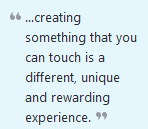Final thoughts about how to run hardware startups
Don’t be afraid. A text like this usually highlights complications and problems that I would prefer to call challenges. Many of the successful projects didn’t have any clue about all the phases they should pass through. They just started working and discovered each time the next step to be solved and they did it.
 Having a global vision of what will happen in the future is important. And for new entrepreneurs it can be a valuable view into a startup’s future. It’s my role in accelerators and business schools to define a company’s steps for the next 2 years in an effort to prevent foreseen problems. But, this vision must not be a barrier for starting something.
Having a global vision of what will happen in the future is important. And for new entrepreneurs it can be a valuable view into a startup’s future. It’s my role in accelerators and business schools to define a company’s steps for the next 2 years in an effort to prevent foreseen problems. But, this vision must not be a barrier for starting something.
A positive about hardware is that there is a lot to be done. It’s known that each new technology appearing in a market creates business opportunities. In hardware every day we have innovations and they are increasing in speed exponentially, so many opportunities are emerging.
But it’s not all about technology: going to the customer and the market is not a certainty and the products are arriving in the market at a slower rate. Finding a good problem to solve is very important to creating a project and many teams are more focused on the solution than on the problems. Attracting attention could be easy with new and cool things, but to find stability is difficult and needs the true acceptance of customers.
Cool and quite successful products are still looking to be useful, like Google glass, but not finding so many situations where they solve a big problem. Drones: an emerging market now facing regulations, with nice user cases but many industries and markets where their presence is not enough. Or wearables, also with nice user cases, but looking for recurrence in its use by customers.
That means good ideas and technologies that were converted to cool devices still need to mature.
Financing. It’s a long race, and you’ll need fuel for it, about 1 year in prototyping and 1 more for going to the market. Be ready to bootstrap as much as possible. Sell an initial product version or find the way to fill your pocket quickly. Also use free things or collaborations like makerlabs, universities or partnerships with companies in the area now. Some of them are launching accelerators that will support these projects.
Raising investment is not easy, but it’s possible. And there are several business models to consider: based on software, subscriptions or hardware as a service. Many of them are more attractive as they only sell one product. They create recurrence, increase LTV and make projects more scalable.
Consider crowdfunding, but not as the solution to all your problems. Try to do it at the right time. So, first start working with contacts. Give information to a small community and go to public visibility just before starting the campaign. Never go to mass media if you have nothing for customers.
You should start with a basic team: maker, designer, business and marketing, probably a coder if software is involved, and it usually is. Find in collaborators what you don’t have and don’t forget universities, research centers or interns coming from these places. It’s so difficult to find all the people that will be needed, so go step by step and you’ll probably learn a lot during the process.
Remember that product is not important. Maybe consider if your product could be converted to a mobile app. Also, you can create a community around the device and its use (as running devices are doing) that’s absolutely unique. Or you can create a business model more based on software or cloud, using hardware only as a medium for your objectives. All these strategies make the hardware device necessary but secondary.
At the end the advice here is so similar to other projects: get experience in the area, find a good problem to be solved, create something useful, put together the team to do it and find the way to make money with it (and not going without enough money to survive until you get profit). Here in hardware there aren’t many options to have success if you are weak in one of the areas. But probably I’ll tell the same thing to any entrepreneur in any market.
The good news is in this area there is a lot of space. In a moment where every single game, app or social network seems to be done, and has hundreds of competitors, there’s still a window of opportunity.
 As mentioned, every barrier you pass is time you earn against your competitors. Don’t forget it during the process.
As mentioned, every barrier you pass is time you earn against your competitors. Don’t forget it during the process.
And there’s another good point: working in this area is amazing for people like me that love technology and business. A hardware project is one of the last chances in a professional career to build something from scratch, be involved in the whole process and have business success at the same time you watch how people are happy using your creation.
Yet in the digital era, creating something that you can touch is a different, unique and rewarding experience.


